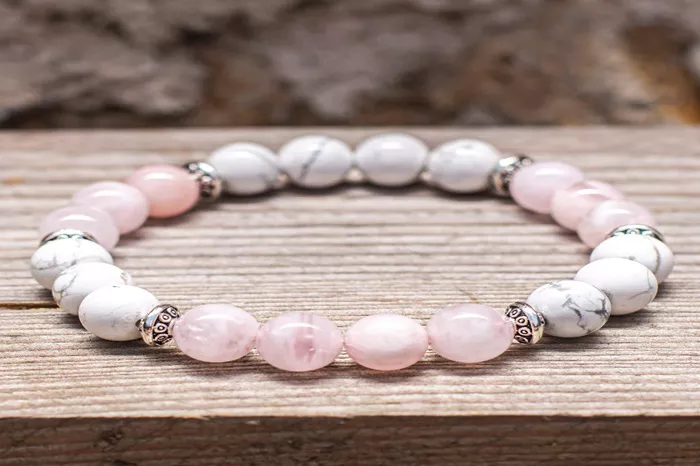Rose quartz, the stone of love and harmony, is a popular gemstone known for its soft, pink hue and soothing energy. It has been used in jewelry for centuries, celebrated for both its aesthetic appeal and its metaphysical properties. As rose quartz continues to rise in popularity, particularly in bracelets, necklaces, and other jewelry pieces, it’s essential to be able to distinguish between real and imitation rose quartz to ensure you’re investing in an authentic piece. Here are three reliable ways to confirm the authenticity of your rose quartz bracelet.
Visual Inspection
The first step in identifying genuine rose quartz is a close examination of its appearance. Authentic rose quartz has distinct visual characteristics that set it apart from synthetic or imitation versions.
Color Consistency
Genuine rose quartz typically has a soft, milky, pink hue with subtle variations in color. This natural stone often features a translucent, cloudy appearance, with some areas slightly more opaque than others. Fake rose quartz, on the other hand, may appear overly vibrant, with uniform coloring across the entire piece. An unnaturally bright or uniform shade could indicate that the stone is dyed or made from plastic or glass.
Inclusions and Bubbles
Real rose quartz is rarely perfect. It often contains natural inclusions, such as tiny cracks or imperfections, which add to its uniqueness and beauty. These inclusions may appear as tiny wisps or veils within the stone. Additionally, you might spot some minute internal fractures, which are part of the stone’s natural formation. Fake rose quartz, particularly glass or plastic imitations, may have visible bubbles or smooth surfaces, which are not characteristic of genuine rose quartz.
Surface Texture
When you run your fingers over real rose quartz, the surface should feel smooth, but with slight imperfections or a natural texture that distinguishes it from synthetic materials. A flawless, polished surface with no irregularities may suggest that the stone is not real.
Hardness Test
One of the most definitive ways to test if your rose quartz bracelet is real is by assessing its hardness. Genuine rose quartz falls at a 7 on the Mohs scale of hardness, making it relatively tough and scratch-resistant.
Mohs Hardness Scale
The Mohs scale ranks minerals from 1 (softest) to 10 (hardest). Rose quartz, being a 7 on this scale, should be able to scratch glass but should not be easily scratched by a steel knife. To perform the test, gently try scratching the bracelet’s stone with a steel knife. If the surface gets scratched, it’s likely not real rose quartz, as genuine rose quartz should not be easily marked by a steel knife.
Simple Test
If you don’t have a Mohs scale kit, a simple method is to try scratching a glass surface (like a window or a glass bottle) with the bracelet. Real rose quartz should leave a mark on the glass, but if the bracelet gets scratched or damaged in the process, it may be made from softer materials like plastic or resin.
Temperature Check
Another reliable method for testing the authenticity of rose quartz is by assessing its temperature. Real rose quartz has distinctive thermal conductivity properties that differ from synthetic materials.
Thermal Conductivity
Natural rose quartz has a lower thermal conductivity compared to other materials like glass, plastic, or synthetic stones. This means that when you hold a real rose quartz bracelet, it should feel cool to the touch at first and take longer to warm up compared to imitation stones, which tend to warm up quickly. If the bracelet warms up almost instantly when you hold it, it could be an indication that it’s not authentic rose quartz.
Professional Verification
If you’re still unsure whether your rose quartz bracelet is real, there are professional options available for further verification.
Gemologist Examination
For absolute certainty, consider taking your bracelet to a certified gemologist. They can evaluate the stone’s composition, structure, and other key properties to determine if it is genuine rose quartz.
Laboratory Testing
Some jewelry stores or specialized laboratories offer gemstone testing services that can authenticate your rose quartz bracelet. These tests often involve advanced equipment that can precisely identify the mineral’s composition and origin.
Conclusion
While rose quartz is a relatively affordable gemstone, it is still important to ensure that the jewelry you purchase is genuine. By performing a visual inspection, testing its hardness, and checking its temperature conductivity, you can confidently determine whether your rose quartz bracelet is authentic. For the most accurate results, a professional gemologist or laboratory testing can provide peace of mind. With these methods in hand, you’ll be able to enjoy your rose quartz bracelet with confidence, knowing that it’s as real as the love and harmony it symbolizes.
Related topics:

